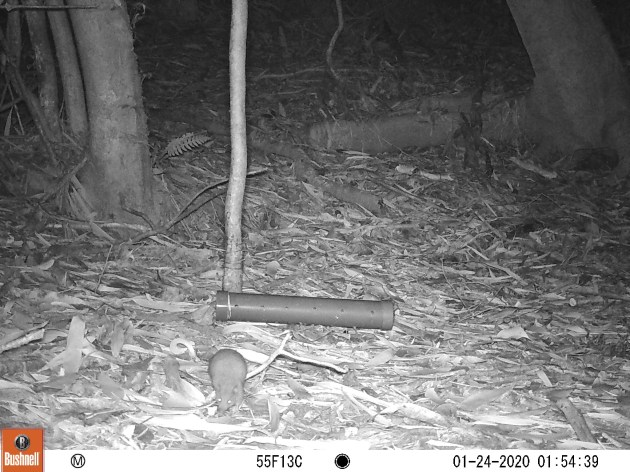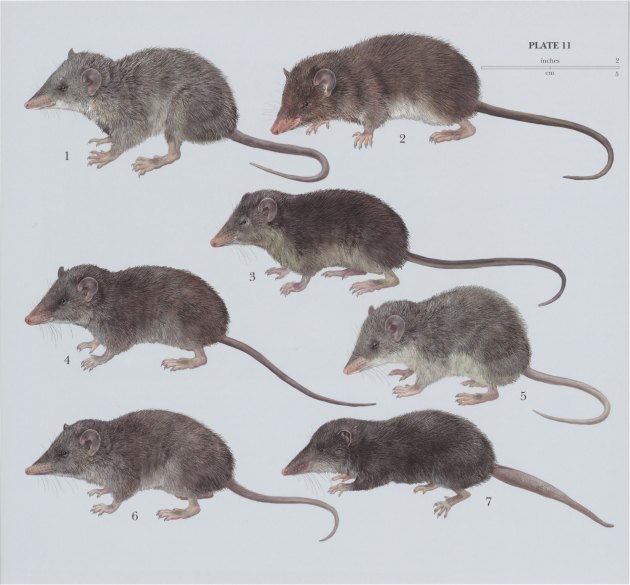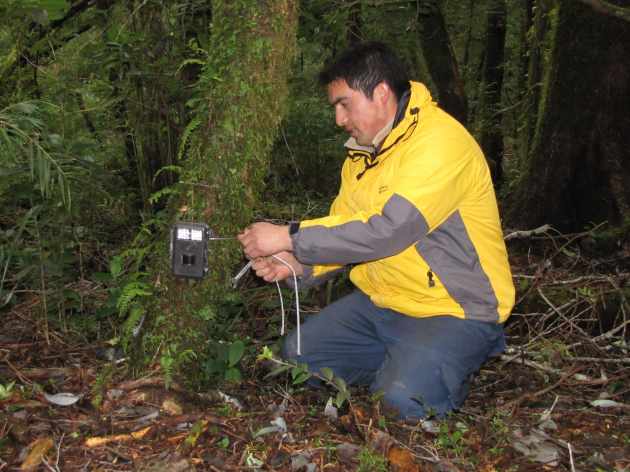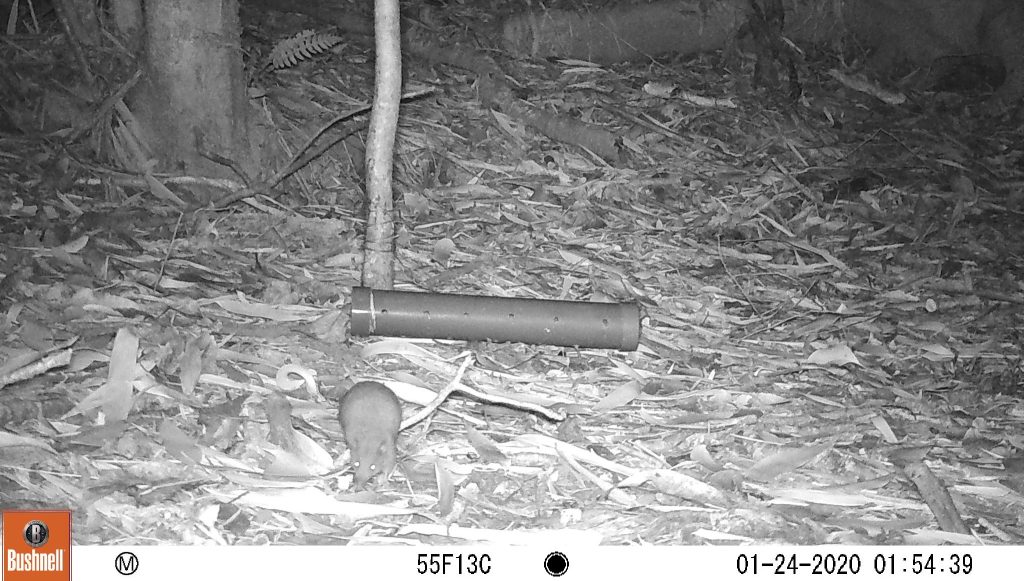Yes, you read that right. In the forests of Chile’s Valdivian Coastal Reserve, there is a small mammal known, in English, as the “long-nosed Chilean shrew opossum.” In Spanish, it’s comadrejita trompuda, and to scientists, it’s Rhyncholestes raphanarus.
In all languages, this fascinating relict marsupial is the last of its kind—the only known living member of the Rhyncholestes genus of shrew opossum remaining on Earth. Scientists believe it has lived, largely unchanged, in the temperate forests of Chile and Argentina since at least the Oligocene (between 36 and 23 million years ago).
Still, despite its longevity and all the advancements in science and knowledge, notes researcher Eduardo Silva of the Universidad Austral de Chile, “the long-nosed Chilean shrew opossum [remains] one of Chile’s least-known mammals.”
The Least Known of the Little Known
The first long-nosed Chilean shew opossum was described by science in 1924. Zoologist Wilfred Osgood was exploring the West Coast of South America and spotted a small “shrew-like” animal in the temperate rainforest on Chile’s Chiloé island. While he never documented long-nosed shrew opossums on the mainland, he predicted the species would be found in similar temperate rainforests within Chile (and possibly Argentina).
He was right.
There are two known populations of long-nosed Chilean shrew opossum. One on the island and one in the rainforest of the mainland. The current consensus is that thousands of years ago, part of what is now Chiloé island was covered in glaciers—except for an area of rainforest that remained unglaciated and connected to the continental land mass.
In geologic time, the 12,000 years or so since the end of the last Ice Age is less than a blink. The two populations of long-nosed Chilean shrew opossums don’t appear to have had enough time to develop the differences that would separate them into subspecies of Rhyncholestes. And though some scientists have suggested they should be divided, the most comprehensive morphological study of long-nosed Chilean shrew opossum I could find (published in 2020) supports the single-species designation.
A (Very) Brief Evolutionary History of South America’s Shrew Opossums

Which brings us to a quick dip into Linnaean taxonomy. There are seven species of South American shrew opossum, including the Chilean long-nosed. All seven are part of an ancient but still surviving Order of marsupials called Paucituberculata (which, like a lot of Linnaean taxonomy, sounds like a spell from Harry Potter.)
The earliest fossils of the Order Paucituberculata are recorded only from Antarctica and South America and date from the Late Cretaceous (between 100.5 million to 66 million years ago). Ultimately, Paucituberculata split into six different Families. Five went extinct. One survived.
Caenolestidae, the family that contains the seven remaining South American opossum species, was that lucky evolutionary winner. As noted above, depending on which source you consult and when, the general consensus is that there are five species in the genus Caenolestes, one in the genus Lestoros and one in Rhynochlestes.
Spoiler Alert: Shrew Opossums are Not Shrews
Despite its shrewish name and what could be considered a somewhat rat-like appearance, the long-nosed shrew opossum is neither a “true shrew” nor a rodent. It’s on a completely different branch of the mammal family tree. (And pound for pound possibly the weirdest branch.)
Shrew opossums are marsupials—very, very distantly related to the kangaroos and wallabies of Australia, and the Virginia opossums of North America. The main thing to know here is that unlike placental mammals (think: true shrews, other shrews, elephants, dogs, rats and, well, people) whose young develop within the mother’s body, marsupial mammals carry their embryonic young outside their bodies.
But unlike those kangaroos and wallabies, none of the seven surviving species of South American shrew opossum, including the long-nosed Chilean, have an obvious pouch (called a marsupium). In this, shrew opossums are more akin to the similarly pouchless Virginia opossum.
Like embryonic Virginia opossums, embryonic shrew opossums attach to their mother’s teats (mammae). The teats then swell in their mouths to help them hold on until they’re large enough to forage on their own, or to be left alone for a short time in a burrow or a nest.
At least, that’s what scientists think. Not all that much is known about the behavioral ecology of shrew opossums in general, and that goes triple for long-nosed Chilean shrew opossums.

What’s in a Name? A Lot of Differences from Other Shrew Opossums
Might as well start with the nose (rostrum). It’s the longest nose of all shrew opossums and the obvious source of the animal’s name (at least in English). The also have the smallest ears. The differences go on from there. And despite a lengthy literature search, I couldn’t find any consistent measurements of exactly how long the long-nosed Chilean shrew opossum’s nose is. Most sources say something along the lines of “the longest rostrum of all South American shrew opossums.” So we’re going with that.
The measurements below are from the 2020 morphological study of long-nosed Chilean shrew opossums. But even the authors of that paper noted they only had 77 specimens (or parts of specimens) housed in museums around the world to work with. So there are still many gaps in knowledge, which is one of the reasons there’s so much “appears to,” “suggests” and “could” language in this story.
That said, here’s the rundown: The long-nosed shrew opossum is mostly brown or ‘brownish-gray.” Males appear to be slightly larger and heavier than females, but both sexes are still small and light: weighing, on average, around 1.5 to 1 ounce (45g and 38g) for males and females, respectively.

There are the same slight differences in average length. Males come in around 7.5 inches and females around 7 (including the tail). The long-nosed shrew opossum’s tail is shorter and stubbier than other shrew opossum tails suggesting that it doesn’t climb trees and spends most of its time on the ground in burrows or nests. And it can store fat in its tail.
In fact, that tail—that can expand from 4-5mm in diameter during summer to 9-11mm in early winter—is where the long-nosed Chilean shrew opossum gets one of its names: R. raphanarus. Raphanarus means “radish tail” and according to one source, is a reference to the seasonal accumulation of fat in the tail and the belief that it looks like, well, a radish.
Because of that adaptation, there is speculation that they may experience torpor during the Austral winter. There isn’t enough data to say for certain that long-nosed Chilean shrew opossums hibernate (or enter extended torpor). Another knowledge gap. There’s doubt that they enter torpor because they have been spotted on snow pack, they’re active year round, and maybe most telling, reproductively active males have been captured in all seasons.
Join us!
Make a lasting impact for nature when you join The Nature Conservancy
Alone among other shrew opossum species, female long-nosed shrew opossums have seven nipples instead of four. But no one has captured or documented a female long-nosed Chilean shrew opossum with young so no one really knows the average number of a brood or litter. Or how long embryonic long-nosed shrew opossums take to grow big enough to survive alone for short periods in a nest or burrow. Unlike the reproductively active males as mentioned above, reproductively active and lactating females without attached young have been captured only in summer.
Both sexes are seen and captured most often at night, suggesting a nocturnal life cycle. They eat mostly insects, fungi and seeds.
Scientists also found that the long-nosed Chilean shrew opossum has only 22 caudal vertebrae instead of 27 like other shrew opossums. (Caudal vertebrae are the bones of the tail.) Long-nosed shrew opossums also have the “most developed and most conspicuous” orbitosphenoid of all shrew opossums (a bone that helps give the skull rigidity and also supports the olfactory section of the brain.)
In fact, authors of the 2020 study also speculated that there are so many additional differences in the teeth, jaw and bony structures of the long-nosed Chilean shrew opossum skull that it might represent a different evolutionary path than the other six shrew opossum species. Which would definitely be a very interesting finding. For now, there aren’t enough long-nosed Chilean shrew opossum specimens or pieces of specimens for researchers to do more than speculate.
TNC + Chilean Long-Nosed Shrew Opossums
One of the more obvious reasons Chilean long-nosed shrew opossums are so little studied is because, well, the places they live can be difficult to get to. And field work to monitor species in remote areas is time-consuming, inherently time-limited, often dangerous, and pretty much always expensive. In the nearly 90 years between the first description of a long-nosed Chilean shrew opossum in 1924 and about 2011, the species was only documented in 21 different sites, most within the Valdivian rainforests of Chile and a small neighboring part of Argentina.
They seem to prefer undisturbed temperate rainforests, but in the 1980s and 90s, thousands of hectares of forests were logged, burned and some of the land reused for eucalyptus plantations.

In part, it was those burned and logged forests and the opportunity for conservation and restoration that brought TNC to this part of Chile. In 2003, TNC acquired around 60,000 hectares in a public auction that included 3,500 hectares of eucalyptus plantations and created the Valdivian Coastal Reserve. Then, it promoted the creation of the Alerce Costero National Park by donating around 9,500 hectares to Chile’s National Forest Corporation (CONAF) (in Spanish) using a model that combines public and private conservation efforts and community involvement.
Camera Traps for Science
Those public and private conservation efforts include a monitoring framework that uses camera traps. One of the many advantages rugged, long-lasting remote cameras is that they can be left in place for long periods of time, like say in the temperate rainforests of the Valdivian Coastal Reserve. And they can see in the dark.
In this case, according to a paper published in 2023, using data collected from the camera traps of a monitoring program in the Reserve and Alerce Costero National Park, as well as data obtained through other projects, researchers and park rangers detected the presence of long-nosed Chilean shrew opossums on 31 occasions, across 17 sites: 15 in the Valdivian Coastal Reserve and 2 in the adjacent Alerce Costero National Park.
The long-nosed Chilean shrew opossum was detected during all four seasons in areas of the evergreen and larch forests and, occasionally, in eucalyptus plantations. For Danilo González, TNC’s park ranger coordinator in the Valdivian Coastal Reserve and a co-author on the recent paper, “it is a pleasure to find the species in different environments, in a greater range of habitats.”
Those findings represent a significant increase in the number of sites with confirmed sightings of the species—nearly equaling the previous record of 21 sites registered in all those years between 1924 and 2011.

Scientists note that scarcity of data (again) doesn’t allow them to speak about long-nosed shrew opossum population numbers. They do note that the species has a broader presence in the area than they’d previously known. Despite the presence of camera traps, the long-nosed Chilean shrew opossusm has not been documented north of the Valdivia River.
“You can see the burned larch trees in the higher areas, and in other spots, you can see the replacement process. Twenty-five years ago, the area was the cause of the Chilean forest tragedy, and today, it is one of the main examples of conservation in Chile, a total change of trajectory,” Silva points out.
And good news for long-nosed Chilean shrew opossums, the researchers who study them, and people like me, who are just happy to know an animal that has survived for millennia is still there—living its life in the rainforests of the Valdivian Coast Reserve. And in other places we may never know about.




I think I saw a shrew possum in my yard tonight .I have been searching online this is the 9nly thing I could find.
Thank you for writing this article.
Shrews are lovely even when they are not real Shrews 🙂